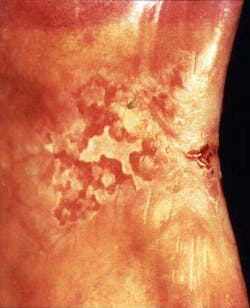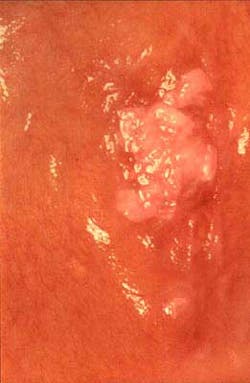Almost 42,000 Americans will be diagnosed with oral or throat cancer this year. The 5-year survival rate of those diagnosed is only slightly more than 64%. When cancer is detected and treated early, treatment-related health problems are reduced. As we observe the 14th Annual Oral Cancer Awareness Month, this April, the American Academy of Oral & Maxillofacial Pathology, American Academy of Periodontology, the American Association of Oral and Maxillofacial Surgeons and the American Dental Association have joined the Oral Cancer Foundation in its campaign to remind everyone that regular oral cancer examinations from your dental professional are the best methods to detect oral cancer in its early stages. Regular dental visits can improve the chances that any suspicious changes in your oral health will be caught early, at a time when cancer can be treated more easily. In between dental visits, it is important for patients to be aware of the following signs and symptoms, and to see their dentist if they do not disappear after two weeks. • a sore or irritation that doesn't go away • red or white patches • pain, tenderness or numbness in mouth or lips • a lump, thickening, rough spot, crust or small eroded area • difficulty chewing, swallowing, speaking, or moving your jaw or tongue • a change in the way your teeth fit together when you close your mouth
Erythroleukoplakia
Leukoplakia
Factors That May Cause Cancer Research has identified a number of factors that may contribute to the development of oral cancer. Those at an especially high risk of developing oral cancer are heavy drinkers and smokers older than 50.The human papilloma virus version 16, which is sexually transmitted, is related to the increasing incidence of mouth cancer in non-smoking patients. It is likely that there is a complex interaction of many external and internal factors that play a role in the development of oral cancer.
Factors That May Cause Cancer Research has identified a number of factors that may contribute to the development of oral cancer. Those at an especially high risk of developing oral cancer are heavy drinkers and smokers older than 50.The human papilloma virus version 16, which is sexually transmitted, is related to the increasing incidence of mouth cancer in non-smoking patients. It is likely that there is a complex interaction of many external and internal factors that play a role in the development of oral cancer.
Your mouth is one of your body's most important early warning systems. Don't ignore any suspicious lumps or sores that last more than two weeks. Should you discover something suspicious, make an appointment for a prompt examination. Early treatment may well be the key to complete recovery. For more information about oral cancer, its diagnosis and treatment, visit the following websites: Oral Cancer Foundation(1); The American Academy of Oral and Maxillofacial Pathology (AAOMP)(2), The American Academy of Periodontology (AAP)(3); Saving Faces, Changing Lives — The American Association of Oral and Maxillofacial Surgeons (AAOMS)(4); and the American Dental Association’s (ADA's) consumer Web site(5). The American Dental Hygienists’ Association (ADHA) has information on Oral Health Fast Facts: Add a Few to Your Next Health Story(6) and an Oral Cancer Fact Sheet. (7) A recent study examined the factors associated with receiving treatment and mortality among Medicaid patients with head and neck cancers.(8) Included in the study were 1,308 Medicaid beneficiaries (ages 18 to 64 years). The study used Medicaid claims linked with cancer registry data for two states, California and Georgia, for 2002 through 2006. The main outcome measures were receipt of treatment and 12- and 24-month mortality. The study suggests that less than one-third of Medicaid patients were diagnosed with cancer at an early stage. Overall, black patients were less likely to receive surgical treatment and more likely to die than white patients. Older age and disability status also were associated with increased 12-month mortality. According to the results, patients in California who were alive for at least 12 months have about half the odds of dying within 24 months compared with those in Georgia. Another study showed that aspirin appears to offer significant protection against head and neck (HNC) cancer.(9) Nonsteroidal anti-inflammatory drugs (NSAIDs) can lower the risk of cancer, mainly by reducing chronic inflammation, a dynamic force in the development of many cancers. NSAIDs have been shown to inhibit the production of the cyclooxygenase-2 (COX-2) enzyme. Interruption of this pathway slows the growth of abnormal cells and encourages apoptosis, both of which can prevent cancer development. Studies also suggest that NSAIDs decrease the proliferation of cells and slow the growth of blood vessels that supply blood to tumors. We also know that a history of chronic inflammatory disease in the oral cavity may be associated with tumor HPV status in patients with head and neck squamous cell carcinoma (HNSCC). This association seems to be stronger among patients with oropharyngeal cancer compared with those who have oral cavity or laryngeal SCC.(10) The incidence of human papillomavirus (HPV)-positive head and neck squamous cell carcinoma (HNSCC) has rapidly increased over the past 30 years.(11) A new study shows that CH1-domain inhibitors represent a novel class of p53-reactivation therapeutics for managing HPV-positive HNSCC patients.(11) In other words, the researchers have designed a drug to block incidence of head, neck cancer caused by HPV virus. Many oral and pharyngeal cancers (OPC) are preventable. Early detection improves survival rates. Dental hygienists and dentists have opportunities to help reduce the oral cancer burden among their patients. An oral cancer exam is painless and quick, and it takes only a few minutes. Do it!(12,13) To view a PDF of Detecting Oral Cancer: A Guide for Health Care Professionals, click here.References and links 1. http://oralcancerfoundation.org/. 2. http://www.aaomp.org. 3. http://www.perio.org. 4. http://www.aaoms.org. 5. http://www.mouthhealthy.org. 6. http://www.adha.org/resources-docs/72210_Oral_Health_Fast_Facts_&_Stats.pdf. 7. http://www.adha.org/resources-docs/7231_Oral_Cancer_Fact_Sheet.pdf. 8. JAMA Otolaryngol Head Neck Surg. Published online April 18, 2013. doi:10.1001/jamaoto.2013.2549. 9. J C Wilson, L J Murray, C M Hughes, A Black and L A Anderson. Non-steroidal anti-inflammatory drug and aspirin use and the risk of head and neck cancer. Br J Cancer 108: 1178-1181; advance online publication, February 28, 2013; doi:10.1038/bjc.2013.73. 10. Tezal M, Scannapieco FA, Wactawski-Wende J, et al. Local Inflammation and Human Papillomavirus Status of Head and Neck Cancers. Arch Otolaryngol Head Neck Surg. 2012;138(7):669-675. doi:10.1001/archoto.2012.873. 11. Xie1 X, Piao L, Bullock BN, Smith A, Su T, Zhang M, Teknos TN, Arora PS and Pan Q. Targeting HPV16 E6-p300 interaction reactivates p53 and inhibits the tumorigenicity of HPV-positive head and neck squamous cell carcinoma. Oncogene advance online publication 11 March 2013; doi: 10.1038/onc.2013.25/ 12. http://www.sixstepscreening.org/oral-cancer. 13. http://www.nidcr.nih.gov/OralHealth/Topics/OralCancer/DetectingOralCancer.htm.
About the Author
Sign up for our eNewsletters
Get the latest news and updates





